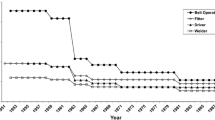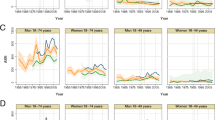Abstract
This study examines for the first time cancer incidence between radiation and non-radiation workers in nuclear power facilities in the Republic of Korea. Radiation workers were defined as persons who were issued with a dosimeter at nuclear power facilities, until 2005. All analyses were conducted on male workers only (in total 16,236 individuals) because of the sparseness of females. Statistical analyses were carried out using the standardized incidence ratio (SIR), to compare the cancer risks of radiation and non-radiation workers with those of the general population, and the χ2 trend test was used to investigate any increase in cancer rates with dose. Poisson regression was also used to estimate the rate ratio (RR) and the excess relative risk (ERR) after considering the confounding effect due to smoking. During 1992–2005, 99 cancer cases in 63,503 person-years were observed among 8,429 radiation workers, while 104 cancer cases were observed in 48,301 person-years among 7,807 non-radiation workers. When compared with the site- and age-specific cancer rates for the male population of Korea, the SIR for all cancers combined was 1.07 [95% confidence interval (CI) 0.87–1.30] for radiation workers, and 0.88 (95% CI 0.72–1.06) for non-radiation workers, respectively. The RR for radiation workers compared with non-radiation workers was 1.18 (95% CI 0.89–1.58) for all cancers combined. The SIRs for thyroid cancer were noticeably high for both radiation and non-radiation workers, possibly due to the screening effect, but analysis of the RR showed that there was no statistically significant difference in thyroid cancer incidence rates between the two groups. For lung cancer, radiation workers showed a higher incidence rate as compared to non-radiation workers, with the RR being 3.48 (95% CI 1.19–11.48). A χ2 trend test showed that there was no evidence for an increase in cancer rate with increasing cumulative dose for all cancers combined (p = 0.5108). The ERR per Sievert was estimated to be 1.69 (95% CI −2.07 to 8.21) for all cancers combined assuming a 10 years lag time. Consequently, a significant excess of cancer incidence among radiation workers in the nuclear power industry in Korea was not observed. Further follow-up and an expansion of the cohort are needed to overcome the lack of statistical power in the study.

Similar content being viewed by others
References
Ahn YS, Park RM, Koh DH (2008) Cancer admission and mortality in workers exposed to ionizing radiation in Korea. J Occup Environ Med 50:791–803
Atkinson WD, Law DV, Bromley KJ, Inskip HM (2004) Mortality of employees of the United Kingdom Atomic Energy Authority, 1946–97. Occup Environ Med 61:577–585
Breslow NE, Day NE (1987) Statistical methods in cancer research: vol. II-the design and analysis of cohort studies. International Agency for Research on Cancer, Lyon
Cardis E, Vrijheid M, Blettner M, Gilbert E, Hakama M, Hill C, Howe G, Kaldor J, Muirhead CR, Schubauer-Berigan M, Yoshimura T, Bermann F, Cowper G, Fix J, Hacker C, Heinmiller B, Marshall M, Thierry-Chef I, Utterback D, Ahn Y–O, Amoros E, Ashmore P, Auvinen A, Bae J-M, Solano J, Biau A, Combalot E, Deboodt P, Diez Sacristan A, Eklof M, Engels H, Engholm G, Gulis G, Habib R, Holan K, Hyvonen H, Kerekes A, Kurtinaitis J, Malker H, Martuzzi M, Mastauskas A, Monnet A, Moser M, Pearce MS, Richardson DB, Rodriguez-Artalejo F, Rogel A, Tardy H, Telle-Lamberton M, Turai I, Usel M, Veress K (2005) Risk of cancer after low doses of ionizing radiation: retrospective cohort study in 15 countries. Br Med J 331:77–82
Cardis E, Vrijheid M, Blettner M, Gilbert E, Hakama M, Hill C, Howe G, Kaldor J, Muirhead CR, Schubauer-Berigan M, Yoshimura T, Bermann F, Cowper G, Fix J, Hacker C, Heinmiller B, Marshall M, Thierry-Chef I, Utterback D, Ahn YO, Amoros E, Ashmore P, Auvinen A, Bae JM, Bernar J, Biau A, Combalot E, Deboodt P, Diez Sacristan A, Eklöf M, Engels H, Engholm G, Gulis G, Habib RR, Holan K, Hyvonen H, Kerekes A, Kurtinaitis J, Malker H, Martuzzi M, Mastauskas A, Monnet A, Moser M, Pearce MS, Richardson DB, Rodriguez-Artalejo F, Rogel A, Tardy H, Telle-Lamberton M, Turai I, Usel M, Veress K (2007) The 15-country collaborative study of cancer risk among radiation workers in the nuclear industry: estimates of radiation-related cancer risks. Radiat Res 167:396–416
Hammer GP, Fehringer F, Seitz G, Zeeb H, Dulon M, Langner I, Blettner M (2008) Exposure and mortality in a cohort of German nuclear power workers. Radiat Environ Biophys 47:95–99
Howe GR, Zablotska LB, Fix JJ, Egel J, Buchanan J (2004) Analysis of the mortality experience amongst U.S. nuclear power industry workers after chronic low-dose exposure to ionizing radiation. Radiat Res 162:517–526
Ivanov VK, Gorsky AI, Kashcheev VV, Maksioutov MA, Tumanov KA (2009) Latent period in induction of radiogenic solid tumors in the cohort of emergency workers. Radiat Environ Biophys 48(3):247–252
Iwasaki TI, Murata M, Oshima S, Miyake T, Kudo S, Inoue Y, Narita M, Yoshimura T, Akiba S, Tango T, Yoshimoto Y, Shimuzu Y, Sobue T, Kusumi S, Yamagishi C, Matsudaira H (2003) Second analysis of mortality of nuclear industry workers in Japan, 1986–1997. Radiat Res 159:228–238
Kaiser JC, Jacob P, Blettner M, Vavilov S (2009) Screening effects in risk studies of thyroid cancer after the Chernobyl accident. Radiat Environ Biophys 48:169–179
Land C, Gilbert E, Smith JM (2003) Report of the NCI-CDC working group to revise the 1985 NIH radioepidemiological tables. NIH Publication No. 03-5387, Bethesda, MD, USA
National Research Council (NRC) (2005) Health risk from exposure to low levels of ionizing radiation: BEIR VII-Phase2. National Academy Press, Washington, DC
Pierce DA, Shimizu Y, Preston DL, Vaeth M, Mabuchi K (1996) Studies of the mortality of atomic bomb survivors. Report 12, Part I. Cancer: 1950–1990. Radiat Res 146:1–27
Pierce DA, Sharp GB, Mabuchi K (2005) Joint effects of radiation and smoking on lung cancer risk among atomic bomb survivors. Radiat Res 163:694–695
Preston DL, Lubin JH, Pierce DA, McConney ME (1993) EPICURE user’s guide. Hirosoft International Corporation, Seattle
Shin HR, Won YJ, Jung KW, Kong HJ, Yim SH, Lee JK, Noh HI, Lee JK, Pisani P, Park JG (2005) Nationwide cancer incidence in Korea, 1999–2001: first result using the national cancer incidence database. Cancer Res Treat 37:325–331
Vrijheid M, Cardis E, Blettner M, Gilbert E, Hakama M, Hill C, Howe G, Kaldor J, Muirhead CR, Schubauer-Berigan M, Yoshimura T, Ahn YO, Ashmore P, Auvinen A, Bae JM, Engels H, Gulis G, Habib RR, Hosoda Y, Kurtinaitis J, Malker H, Moser M, Rodriguez-Artalejo F, Rogel A, Tardy H, Telle-Lamberton M, Turai I, Usel M, Veress K (2007) The 15-country collaborative study of cancer risk among radiation workers in the nuclear industry: design, epidemiological methods and descriptive results. Radiat Res 167:361–379
WHO (2005) Report of the UN Chernobyl Forum Expert group “Health”: health effects of the Chernobyl accident and special health care programmes. WHO, Geneva
Zablotska LB, Ashmore JP, Howe GR (2004) Analysis of mortality among Canadian nuclear power industry workers after chronic low-dose exposure to ionizing radiation. Radiat Res 161:633–641
Acknowledgments
This research was supported by a grant of the Korean Ministry of Education, Science and Technology (KOSEF 2009-0062385) and partially by a grant of the Korea Hydro & Nuclear Power Co., Ltd. (E07NS55). The authors appreciate Dr. Dale L. Preston (Hirosoft Inc., USA) and Dr. John B. Cologne (RERF, Japan) for their helpful advice in the analysis of the cohort.
Author information
Authors and Affiliations
Corresponding author
Rights and permissions
About this article
Cite this article
Jeong, M., Jin, YW., Yang, K.H. et al. Radiation exposure and cancer incidence in a cohort of nuclear power industry workers in the Republic of Korea, 1992–2005. Radiat Environ Biophys 49, 47–55 (2010). https://doi.org/10.1007/s00411-009-0247-7
Received:
Accepted:
Published:
Issue Date:
DOI: https://doi.org/10.1007/s00411-009-0247-7




